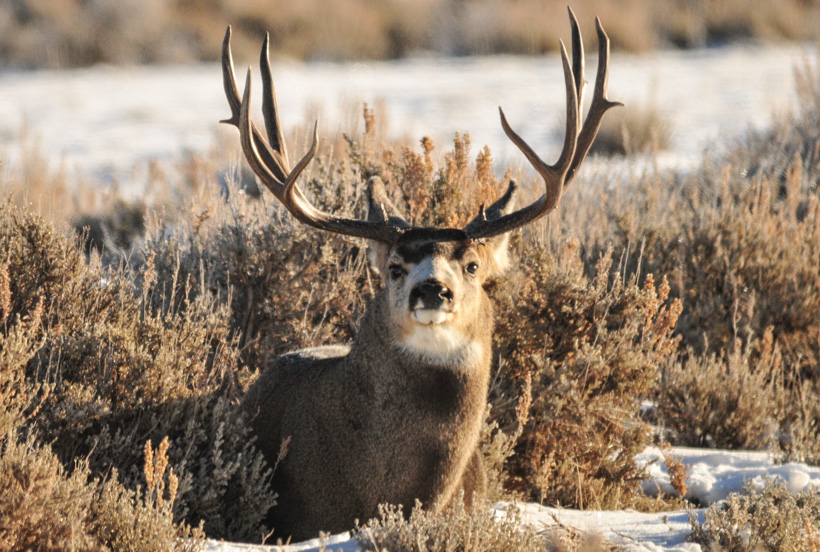By Mike Koshmrl
Jackson Hole News&Guide
Via Wyoming News Exchange
JACKSON — The buck mule deer whose lymph nodes would ultimately test positive for chronic wasting disease went to the dump like any other roadkill. It took two weeks to get back a result that wildlife managers have been dreading for decades.
The buck did not show outward signs of the disease when it was removed from the side of Gros Ventre Road, and tissue samples were taken Nov. 5. Still, its peanut-sized lymph nodes went to a Wyoming laboratory in Laramie, where on Nov. 19 the lab confirmed the presence of the deadly elk, deer and moose disease.
But the rest of the deer, whose deadly malady was unknown to managers at the time, was treated like any other roadkill in Grand Teton National Park.
It went to the carcass dump.
“I’m pretty sure it was put on the landscape in the normal place,” Teton park science and resources chief Sue Consolo-Murphy said. “We believe it was rather promptly consumed by scavengers.”
There’s a good likelihood that wildlife carcasses from Teton park that need disposal, and from elsewhere in the valley, will have a different fate in the future.
Chronic wasting disease, often called CWD, is unlike most other wildlife illnesses in that it can persist in the environment just about anywhere. Soils, grasses and water can all be long-term vectors for “prions,” misfolded proteins that eventually destroy the brain and body of their victims. The condition, a transmissible spongiform encephalopathy similar to mad cow disease, invariably kills its ungulate hosts.
Given such concerns there’s plenty of interest in ensuring people don’t spread CWD in how they handle infected animal parts. One solution is to incinerate all carcasses in Jackson Hole, a task that’s trickier than it sounds.
“It’s not impossible, but it’s not super simple either,” said Heather Overholser, Teton County’s superintendent of solid waste and recycling.
Even before CWD’s arrival, which now precludes sending carcasses to uninfected Idaho, Teton County was already in a bind about how to dispose of dead wild game.
As the Horsethief Canyon trash transfer station wraps up the excavation and capping of an old landfill to protect groundwater, the landfill’s closure slated for next summer will eliminate a disposal method that’s worked for decades — hucking carcasses into the transfer station’s animal pit.
“As of next summer,” Overholser said, “we have no solution for our wild game carcasses now that CWD is in the picture.”
The No. 1 option Overholser is pursuing is coming together with about every other land manager and local government in the area to construct a collective incinerator that would both burn hot enough to kill CWD prions — meaning it exceeds 1,000 degrees — and also handle a region’s worth of roadkill.
As it is, the transfer station does away with 30 to 40 tons of wildlife a year, and that’s accepting only the animals collected by the Wyoming Department of Transportation and Wyoming Game and Fish Department. The park and National Elk Refuge have historically done their own thing, using discreet carcass dump sites.
“If we’re to put the facility at the Trash Transfer Station, we would definitely be able to handle the current tonnage,” Overholser said, “but I can’t necessarily say that we could handle being a regional facility.”
The Teton County Board of County Commissioners will discuss the county’s options at a workshop at 1:30 p.m. Monday, she said.
In the months and years ahead, Jackson Hole’s land and wildlife managers will have to grapple with how to manage CWD in other ways.
Wyoming Game and Fish isn’t eyeing any immediate changes to its routine operations, like elk feeding, but regional supervisor Brad Hovinga said he anticipates taking a “collaborative approach” on how to move forward. The process — which isn’t yet settled in terms of format or time — will address issues like closing feedgrounds, which is a step mulled in Wyoming’s CWD Management Plan.
“Chronic wasting disease is a big enough issue for us that we’re on the fast track for finding things that we know will be effective,” Hovinga said.
The refuge has its own work ahead and must put into place plans for when CWD inevitably hops species and starts infecting some of the thousands of ungulates in the Jackson Elk Herd that gather on the refuge each winter. The refuge took some immediate steps, such as requiring hunters to have their animals tested and stepping up biosecurity protocol for staff.
“In terms of immediate actions on the ground, our response is fairly limited,” Refuge Manager Brian Glaspell said. “But in terms of what we’re thinking about in the next decade and 10 decades on the National Elk Refuge, it’s a new day.”
With only a week lapsed since CWD’s arrival became official, Grand Teton National Park still doesn’t know how it will handle potentially infectious carcasses.
Consolo-Murphy consulted with a National Park Service veterinarian about short-term options, and among those she learned about was storing carcasses in a walk-in freezer while awaiting test results.
“That doesn’t take too much time,” she said of buying a freezer, “but we can’t necessarily do that tomorrow.”
Long-term, Teton park — like the county, refuge and everyone else — is still trying to sort out what exactly it’s going to do.
“It’s a new discovery, and it’s not totally unexpected, but we’re still gathering around and having conversations with all the parties,” Consolo-Murphy said. “We’re listening and learning and open to ideas and suggestions.”





